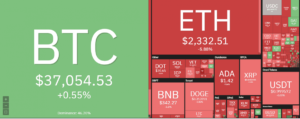
Many stablecoin ecosystems use a reward system to incentivize investors and crypto enthusiasts into adopting and using their stablecoins. These reward systems are part of the factors that contribute to the success of a particular stablecoin.
Although many stablecoins in existence are pegged to fiat currencies, commodities, cryptocurrency reserves, or other stablecoin reserves, many of these stablecoins still differ significantly in their approach towards rewarding users. Before we delve any deeper into the different reward systems that stablecoin developers use, let’s understand what reward systems for stablecoins actually are.
So what exactly are reward systems?
The issuance of stablecoins requires in-depth knowledge and fairly costly implementation. However, most of these stablecoins struggle to break into the market since stiff competition already exists. As a result, most stablecoin companies have devised mechanisms to promote their stablecoins through a “loyalty program.”
Reward systems are loyalty programs that act as marketing and promotion strategies for stablecoin companies. It’s a daunting task for most cryptocurrency projects to manage a reward system for their stablecoin while also ensuring stability in the value of the coin. However, Samecoin protocol managed to achieve this through its family of stablecoins that includes SameUSD.
SameUSD’s reward system
SameUSD ($SUSD) is one of the many stablecoins developed under the Samecoin ecosystem. The SUSD is backed by a basket of other top stablecoins. This allows the value of the SameUSD to always be equal to the US dollar. The SUSD is designed so that no single stablecoin in the reserve will have more shares than the other. The stable mechanism used for SUSD would calculate and adjust the score of the stablecoins in the basket to ensure stability in prices.
The Samecoin protocol employs a reward system that allows users to earn a bonus for minting, staking, saving, and making payments using the SameUSD stablecoin. For Instance, when you complete transactions using SameUSD on the SamePay platform, the Samecoin protocol rewards you with its utility token – Samecoin ($SAME).
SamePay users can easily exchange their Samecoin rewards for some more SameUSD or any other cryptocurrency. Additionally, the bonuses earned in the form of Samecoin can be used within the SamePay platform to pay for trading fees. Users can also use the Samecoin that they earn to pay for trading fees on the SamePay platform. This reward system, designed by the Samecoin team, is quite attractive to crypto users and will significantly promote the adoption of SameUSD over other stablecoins.
Unlike many stablecoins in the market today, the SameUSD offers incentives with real-life value to its users through its exemplary reward system. The SameUSD stablecoin also offers reduced transaction costs, faster transactions, and unmatched resistance to market volatility.
Aside from SameUSD’s prolific reward system, Samecoin’s stablecoin also boasts of several other advantages over other stablecoins including its verifiable reserve and suitability for online payments.
Conclusion
Reward systems are perfect marketing tools that allow cryptocurrency developers to promote their products to an already seemingly crowded market. Using the right strategy like that of the Samecoin team is highly likely to encourage the usage of your cryptocurrency.
Source: https://www.cryptopolitan.com/review-of-the-reward-systems-for-stablecoins/
- Adoption
- Coin
- Commodities
- Companies
- competition
- Costs
- crypto
- cryptocurrency
- currencies
- developers
- Dollar
- ecosystem
- Ecosystems
- exchange
- family
- Fees
- Fiat
- form
- HTTPS
- Including
- Investors
- knowledge
- Loyalty
- Making
- Market
- Marketing
- Offers
- online
- online payments
- Other
- Pay
- payments
- platform
- Products
- Program
- Programs
- projects
- promote
- promotion
- review
- Rewards
- saving
- Shares
- So
- Stability
- stablecoin
- Stablecoins
- Staking
- Strategy
- success
- system
- Systems
- token
- top
- Trading
- transaction
- Transactions
- us
- US Dollar
- users
- utility
- Utility Token
- value
- Volatility
- within










